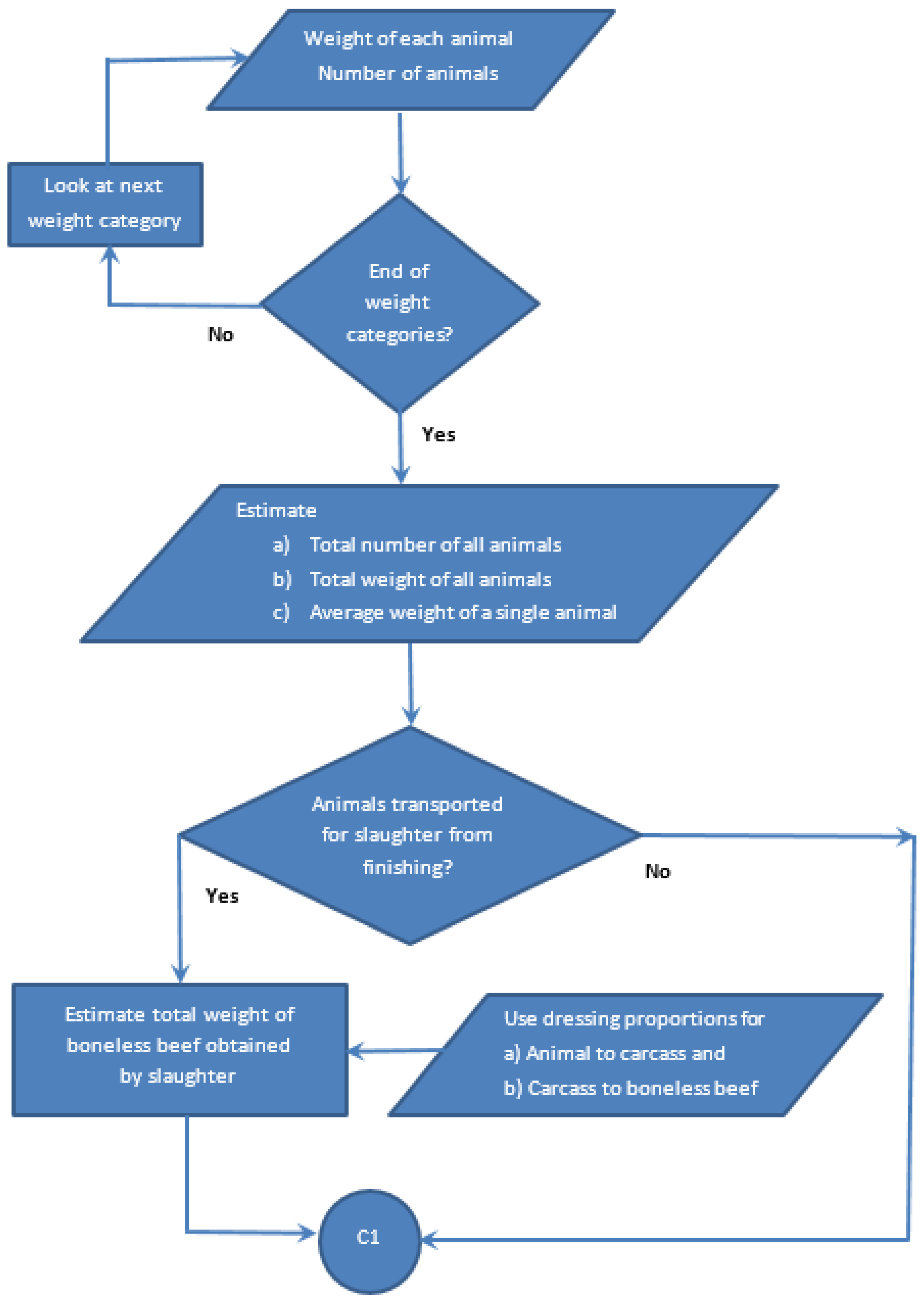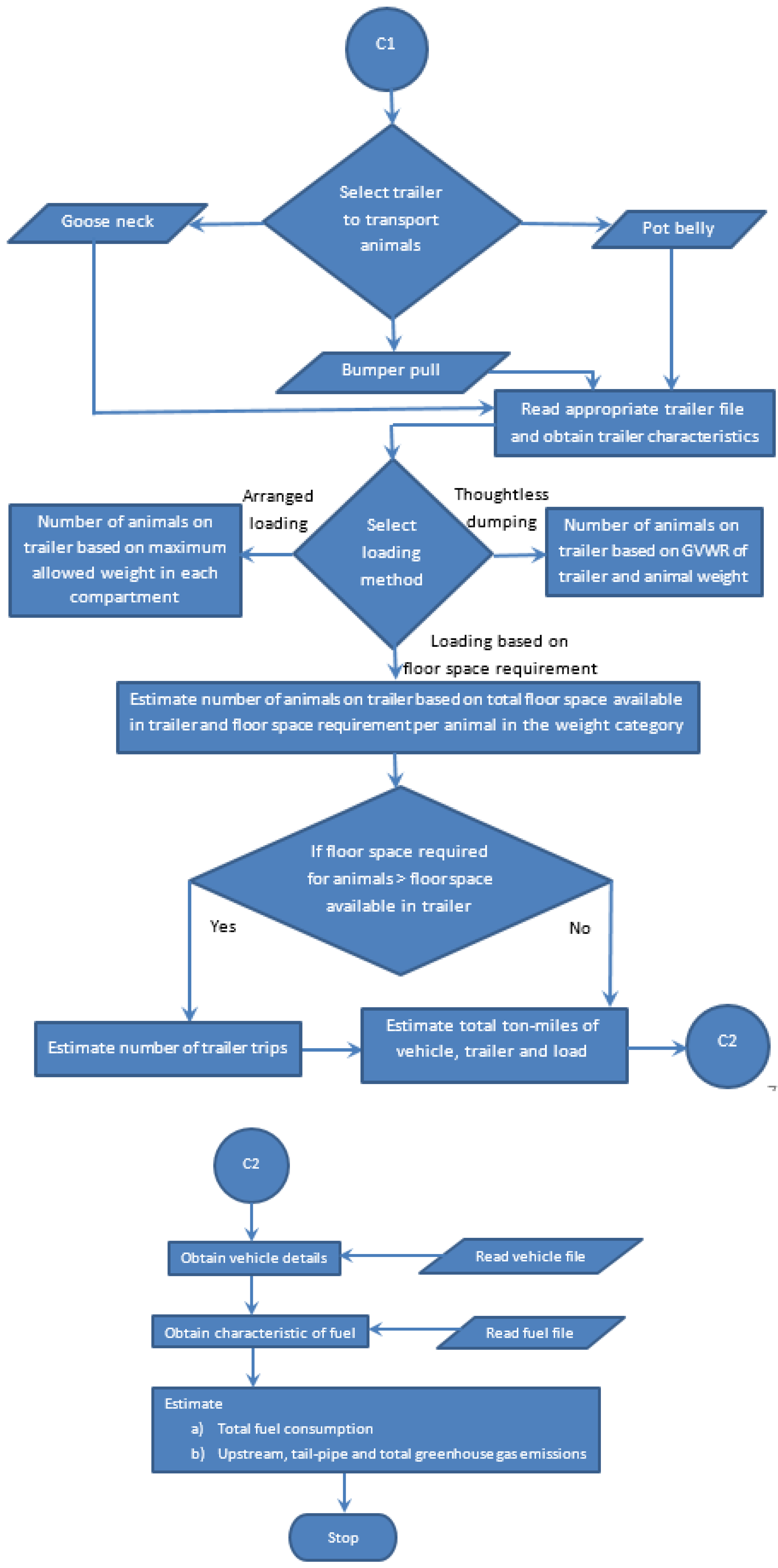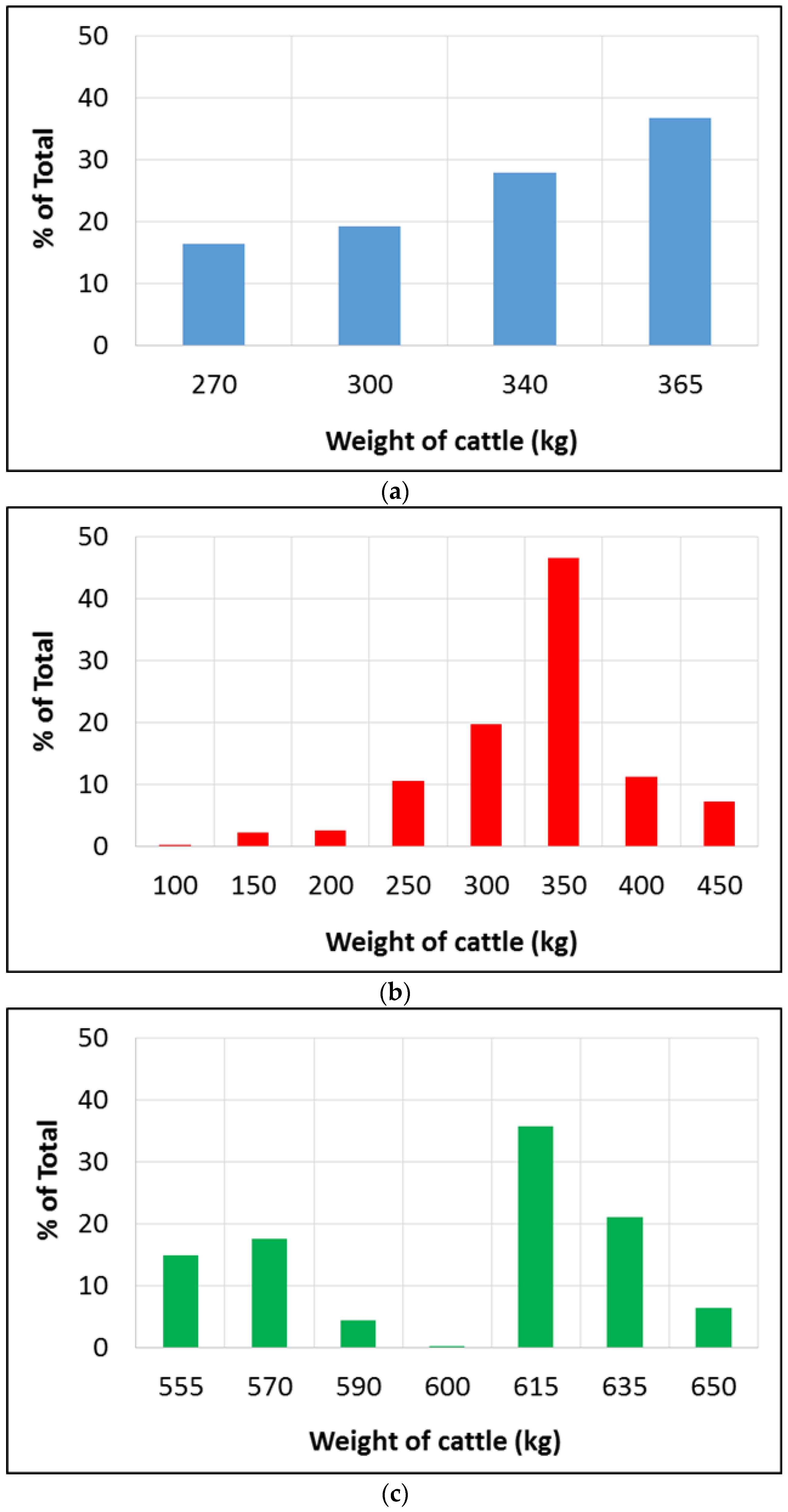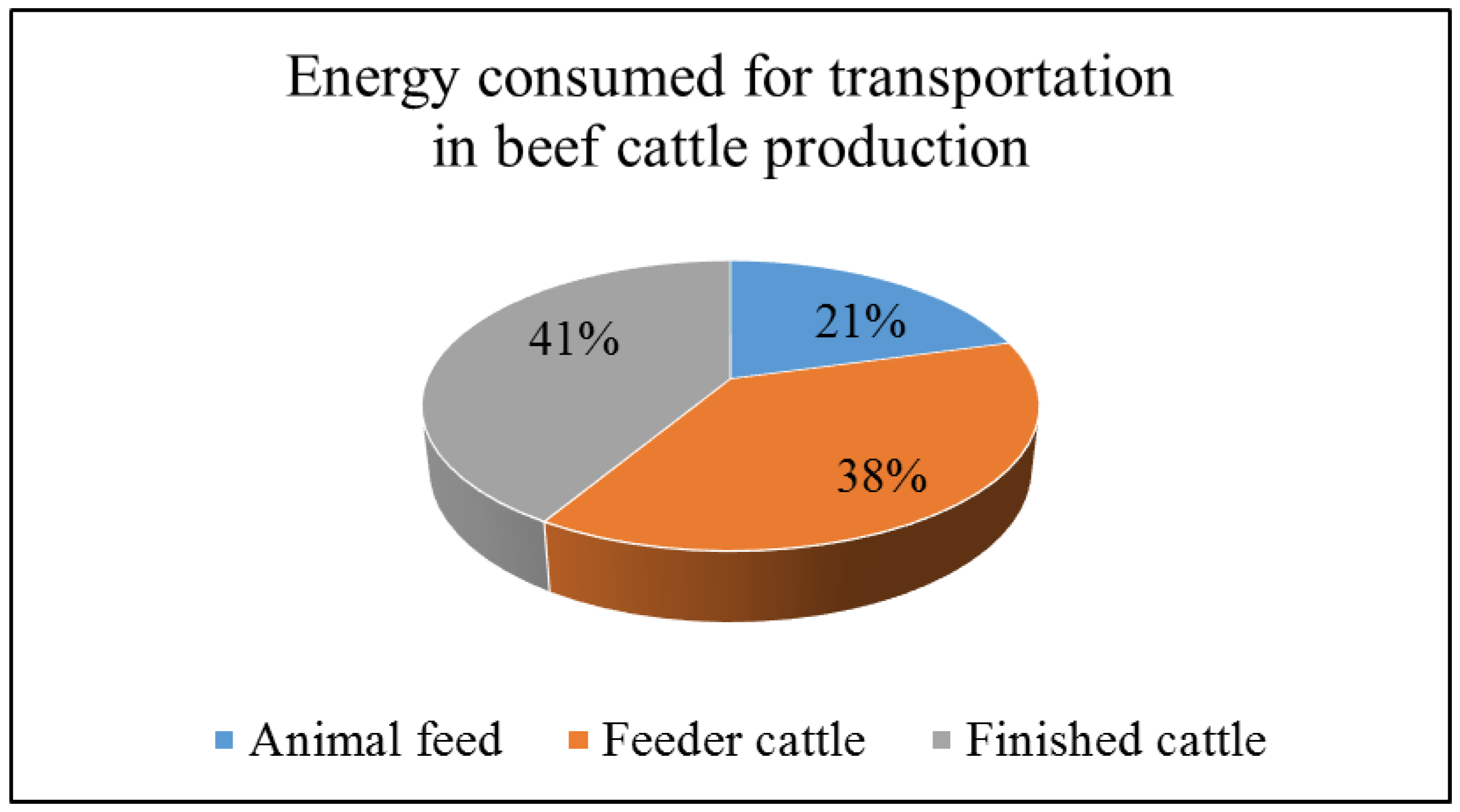Estimation of Energy Consumption and Greenhouse Gas Emissions of Transportation in Beef Cattle Production
Abstract
:1. Introduction
2. Materials and Methods
2.1. A Computer Model to Estimate Energy Requirements and Greenhouse Gas Emissions
2.2. Databases Used
2.2.1. Trailer Database
2.2.2. Vehicle Database
2.2.3. Fuel Database
2.3. Input Requirement from the User
2.4. Estimation of Energy Requirements and Greenhouse Gas Emissions Associated with Transportation in Beef Cattle Production in the Study Region
2.4.1. Assumptions on Trailer, Truck, Fuel, and Animal Loading
2.4.2. Transportation of Animal Feed
2.4.3. Estimation of Vehicle Miles Transported
2.4.4. Truckloads of Animals and Animal Feed
2.4.5. Vehicle Miles Transported
2.4.6. Distribution of Beef Cattle Getting Transported
2.5. Allocation of Environmental Burden to Beef Byproducts
- If possible, allocation should be avoided by expanding the system boundary.
- If it is not possible to avoid allocation, the allocation problem must be solved by using physical relationships among functional units.
- When physical relationships cannot be established, other relationships, including the economic value of the functional outputs, can be used.
3. Results
3.1. Energy Consumption of Transportation in Beef Cattle Production
3.2. Greenhouse Gas Emissions for Transportation in Beef Cattle Production
3.3. Energy Consumption and Greenhouse Gas Emissions of Transporting Cattle to/from Auction
4. Discussion
4.1. Sensitivity of Energy Consumption and Greenhouse Gas Emissions to Model Input Parameters
4.2. Opportunities for Reducing Energy Consumption and Greenhouse Gas Emissions
4.3. Additional Results
5. Conclusions
Acknowledgments
Author Contributions
Conflicts of Interest
Appendix A. Sequence of Computations Used in the Model
- Read user-entered input parameters.
- Estimate the total weight of boneless beef based on weight and number of animals transported in each category and slaughter dressing proportions.
- Obtain trailer parameters from trailer database.
- Estimate capacity of the trailer chosen and estimate total number of trips required to transport all the animals.
- Read vehicle database and get parameters for the vehicle chosen.
- Estimate total ton-miles using the trailer, vehicle parameters and total number of trips.
- Estimate total fuel consumption and greenhouse gas emissions.
- Express fuel consumption and greenhouse gas emissions per animal, and per kg of boneless beef basis.
- Read user-entered input parameters.
- Estimate the total weight of boneless beef based on weight and number of animals fed and dressing proportions.
- Read vehicle database and get parameters for the vehicle chosen.
- Estimate total ton-miles for alfalfa, corn, sorghum, and supplements separately, using weight for each truckload, total number of truckloads, and vehicle parameters.
- Estimate total fuel consumption and greenhouse gas emissions.
- Express fuel consumption and greenhouse gas emissions per animal, and per kg of boneless beef basis.


Appendix B. Demonstration of Model Computations with an Example
| Vehicle Class | GVWR 1 (kg) | Maximum Payload (kg) | Fuel Use L/ton-km | Typical Vehicle 2 |
|---|---|---|---|---|
| 1c | 2719 | 453 | 169.7 | Cars only |
| 1t | 2719 | 680 | 144.6 | Dodge Dakota, Chevrolet Colorado, GMC Canyon |
| 2a | 3852 | 1133 | 94.7 | Dodge Ram 1500, Chevrolet Silverado 1500, Ford F-150 |
| 2b | 4532 | 1677 | 94.7 | Dodge Ram 2500, Chevrolet Silverado 2500, Ford F-250 |
| 3 | 6345 | 2379 | 81.9 | Dodge Ram 3500, Ford F-350, GMC 3500 |
| 4 | 7251 | 3286 | 58.5 | Ford F-450, GMC 4500, Dodge Ram 4500 |
| 5 | 8837 | 3943 | 63.0 | GMC 5500, Dodge Ram 5500, Ford F-550 |
| 6 | 11,783 | 5212 | 50.2 | Ford F-650, Chevrolet Kodiak, GMC TopKick |
| 7 | 14,956 | 8384 | 44.8 | Tractor-trailer, tow, refrigerated truck |
| 8a | 36,256 | 22,660 | 21.4 | Straight truck, tow, dump, etc. |
| 8b | 36,256 | 24,473 | 16.0 | Combination truck, tractor-trailer |
| T | 81,576 | 54,384 | 5.7 | Freight train-single car |
| Trailer | Length (m) | Width (m) | GVWR (kg) | Vehicle Suggestion | Type of Trailer |
|---|---|---|---|---|---|
| PB01 | 16.2 | 2.6 | 24,926 | 8b | Pot belly |
| PB02 | 15.2 | 2.6 | 23,566 | 8b | Pot belly |
| PB03 | 14.6 | 2.4 | 22,660 | 8a | Pot belly |
| PB04 | 13.7 | 2.4 | 20,847 | 8a | Pot belly |
| PB05 | 11.6 | 2.1 | 15,409 | 8a | Pot belly |
| GN01 | 11.0 | 2.4 | 11,766 | 6 | Gooseneck |
| GN02 | 9.8 | 2.4 | 10,215 | 6 | Gooseneck |
| GN03 | 8.5 | 2.0 | 9517 | 6 | Gooseneck |
| GN04 | 8.5 | 2.0 | 9517 | 6 | Gooseneck |
| GN05 | 8.5 | 2.4 | 8854 | 5 | Gooseneck |
| GN06 | 9.1 | 2.1 | 7342 | 5 | Gooseneck |
| GN07 | 7.9 | 2.4 | 7251 | 4 | Gooseneck |
| GN08 | 7.3 | 2.4 | 7251 | 4 | Gooseneck |
| GN09 | 6.1 | 2.3 | 7025 | 4 | Gooseneck |
| GN10 | 5.5 | 2.1 | 6798 | 4 | Gooseneck |
| GN11 | 4.9 | 2.1 | 6798 | 4 | Gooseneck |
| GN12 | 7.3 | 2.1 | 6793 | 4 | Gooseneck |
| GN13 | 7.3 | 2.0 | 6345 | 3 | Gooseneck |
| GN14 | 7.3 | 2.0 | 6345 | 3 | Gooseneck |
| GN15 | 6.1 | 2.0 | 6345 | 3 | Gooseneck |
| GN16 | 4.9 | 2.0 | 5438 | 3 | Gooseneck |
| BP01 | 7.3 | 2.0 | 7106 | 7 | Bumper pull |
| BP02 | 7.3 | 2.0 | 7025 | 7 | Bumper pull |
| BP03 | 5.5 | 2.0 | 6118 | 7 | Bumper pull |
| BP04 | 4.9 | 2.0 | 4532 | 6 | Bumper pull |
| BP05 | 4.9 | 1.8 | 3172 | 5 | Bumper pull |
| BP06 | 4.3 | 2.0 | 4713 | 2b | Bumper pull |
| BP07 | 4.0 | 2.0 | 3766 | 2a | Bumper pull |
| Weight of Finished Cattle in kg (lb) | Number of Cattle |
| 657 (1450) | 63 |
| 634 (1400) | 210 |
| 612 (1350) | 359 |
| 589 (1300) | 43 |
| 566 (1250) | 176 |
| 544 (1200) | 148 |
| Parameter | Value | Details |
|---|---|---|
| Distance transported in km (miles) | 216.8 (129.4) | |
| Trailer used for moving finished cattle | PB01 | Pot belly trailer |
| Truck used for hauling the trailer | 8b | Semi-trailer truck |
| Fuel used in the truck | DSL | Diesel |
| Dressing 1: % of live animal wt. to carcass | 64 | |
| Dressing 2: % of carcass to boneless beef | 62 |
| Animal Weight (kg) | Proportion of Total Animals (%) | Number of Animals in the Trailer |
|---|---|---|
| 657 | 6.3 | 36 |
| 634 | 21.0 | 38 |
| 612 | 35.9 | 38 |
| 589 | 4.3 | 41 |
| 566 | 17.6 | 42 |
| 544 | 14.8 | 44 |
| Animal Feed | Number of Truckloads | Weight of a Single Truckload (t) |
|---|---|---|
| Corn | 10,975 | 21.8 |
| Grain sorghum | 7450 | 20.9 |
| Alfalfa | 4744 | 11.8 |
| Supplements | 580 | 22.7 |
| Parameter | Value | Details |
|---|---|---|
| Market weight of cattle in kg (lb) | 604.1 (1333) | Average finished weight in feedlot |
| Total number of animals fed | 67,800 | Real data for example computation |
| Mortality rate in feedlot (%) | 1.5 | Dead animals not included in calculations |
| Dressing 1 (%) | 64 | Dressing of live animal to carcass |
| Dressing 2 (%) | 62 | Dressing of carcass to boneless beef |
| Distance transported (km) | 24.8 | One-way distance from origin to feedlot |
| Vehicle used for transport | 8b | More details in vehicle database |
| Fuel used in vehicle | DSL | Fuel used in the vehicle is diesel |
Appendix C. Additional Results on Energy Consumption and Greenhouse Gas Emissions for Various Truck-Trailer Combinations on a per km Basis
| Animal feed | Fuel Consumption (L/km) | Greenhouse Gas Emissions (kg of CO2 Equivalent/km) | ||
|---|---|---|---|---|
| Fully-Loaded | Empty | Fully-Loaded | Empty | |
| Alfalfa | 0.65 | 0.36 | 2.27 | 1.29 |
| Corn | 0.89 | 0.36 | 3.1 | 1.29 |
| Grain sorghum | 0.86 | 0.36 | 3.03 | 1.29 |
| Supplements | 0.91 | 0.36 | 3.18 | 1.29 |
| Average | 0.83 | 0.36 | 2.89 | 1.29 |
| Min–Max | 0.65–0.91 | 2.27–3.18 | ||
| Trailer Type | Compatible Vehicle | Fuel Consumption (L/km) | Greenhouse Gas Emissions (kg of CO2 Equivalent/km) | ||
|---|---|---|---|---|---|
| Fully-Loaded | Empty | Fully-Loaded | Empty | ||
| GN01–GN04 | 6 | 0.60–0.68 | 0.29 | 1.72–2.00 | 0.85 |
| GN05–GN06 | 5 | 0.55–0.63 | 0.28 | 1.61–1.85 | 0.80 |
| GN07–GN12 | 4 | 0.44–0.50 | 0.20 | 1.26–1.45 | 0.60 |
| GN13–GN16 | 3 | 0.56–0.60 | 0.28 | 1.64–1.74 | 0.84 |
| Average | 0.55 | 0.26 | 1.62 | 0.75 | |
| 95% CI | 0.52–0.59 | 0.24–0.28 | 1.51–1.72 | 0.69–0.80 | |
| Min–Max | 0.44–0.68 | 0.20–0.29 | 1.26–2.00 | 0.60–0.85 | |
| Trailer Type | Compatible Vehicle | Fuel Consumption (L/km) | Greenhouse Gas Emissions (kg of CO2 Equivalent/km) | ||
|---|---|---|---|---|---|
| Fully-Loaded | Empty | Fully-Loaded | Empty | ||
| PB01–PB02 | 8b | 0.53–0.56 | 0.22 | 1.87–1.97 | 0.76 |
| PB03–PB05 | 8a | 0.72 | 0.29 | 2.51 | 1.02 |
| Average | 0.65 | 0.26 | 2.28 | 0.92 | |
| 95% CI | 0.57–0.73 | 0.23–0.30 | 1.99–2.56 | 0.80–1.04 | |
| Min–Max | 0.53–0.72 | 0.22–0.29 | 1.87–2.51 | 0.76–1.02 | |
| Trailer Type | Compatible Vehicle | Fuel Consumption (L/km) | Greenhouse Gas Emissions (kg of CO2 Equivalent/km) | ||
|---|---|---|---|---|---|
| Fully-Loaded | Empty | Fully-Loaded | Empty | ||
| PB01–PB02 | 8b | 0.52–0.56 | 0.22 | 1.83–1.95 | 0.76 |
| PB03–PB05 | 8a | 0.70 | 0.29 | 2.46 | 1.02 |
| Average | 0.64 | 0.26 | 2.23 | 0.92 | |
| 95% CI | 0.56–0.72 | 0.23–0.30 | 1.95–2.51 | 0.80–1.04 | |
| Min–Max | 0.52–0.70 | 0.22–0.29 | 1.83–2.46 | 0.76–1.02 | |
References
- USDA (United States Department of Agriculture)-NASS (National Agricultural Statistics Service). Field Crops Usual Planting and Harvesting Dates; Agricultural Handbook Number 628; USDA-NASS: Washington, DC, USA, 2010.
- USDA (United States Department of Agriculture)-NASS (National Agricultural Statistics Service). Cattle Inventory Report; Agricultural Statistics Board: Washington, DC, USA, 2014.
- McBride, W.D.; Mathews, K., Jr. The Diverse Structure and Organization of U.S. Beef Cow-Calf Farms; EIB-73; U.S. Department of Agriculture, Economic Research Service-United States Department of Agriculture: Washington, DC, USA, 2011.
- Great Plains Grazing. Available online: http://www.greatplainsgrazing.org/ (accessed on 24 August 2016).
- Klopfenstein, T. North American Beef Industry. In Proceedings of the Beef Methane Conference, Lincoln, NE, USA, 11–12 May 2016.
- Argonne National Laboratory. 2012 GREET Website. Available online: http://greet.es.anl.gov (accessed on 23 August 2016).
- GREET Publications of the GREET Model Development and Applications. Available online: https://greet.es.anl.gov/fleet_footprint_calculator (accessed on 24 August 2016).
- Elgowainy, A.; Han, J.; Poch, L.; Wang, M.; Vyas, A.; Mahalik, M.; Rousseau, A. Well-to-Wheels Analysis of Energy Use and Greenhouse Gas Emissions of Plug-In Hybrid Electric Vehicles; U.S. Department of Energy, Argonne National Lab: Chicago, IL, USA, 2010.
- Tiax LLC. Full Fuel Cycle Assessment: Well-to-Wheels Energy Inputs, Emissions, and Water Impacts; Report Prepared for California Energy Commission, CEC-600-2007-004-F; Tiax LLC.: Lexington, MA, USA, 2007. [Google Scholar]
- Bai, Y.; Oslund, P.; Mulinazzi, T.; Tamara, S.; Liu, C.; Barnaby, M.M.; Atkins, C.E. Transportation Logistics and Economics of the Processed Meat and Related Industries in Southwest Kansas; Final Report from a co-Operative Transportation Research Program with Kansas State University; KU-06-3; University of Kansas and Kansas Department of Transportation: Lawrence, KS, USA, 2007. [Google Scholar]
- Grandin, T. Livestock Trucking Guide; Livestock Conservation Institute: Bowling Green, KY, USA, 1981. [Google Scholar]
- Grandin, T. Recommended Animal Handling Guidelines & Audit Guide: A Systematic Approach to Animal Welfare; American Meat Institute Foundation: Washington, DC, USA, 2010. [Google Scholar]
- Brown, A.; Nae, D.A.; Bezdek, R.; Clark, N.; Corsi, T.M.; Foster, D.; Fruechte, R.D.; Hu, G.; Johnson, J.H.; Kodjak, D.; et al. Technologies and Approaches to Reducing the Fuel Consumption of Medium and Heavy Duty Vehicles; National Research Council of the National Academies, National Academic Press: Washington, DC, USA, 2010. [Google Scholar]
- Ford. RV and Trailer Towing Guide, RV-VER9480–0914. 2015. Available online: http://www.fleet.ford.com/resources/ford/general/pdf/towingguides/Ford_Linc_16RVTTgde_r3_Nov12.pdf (accessed on 23 August 2016).
- Fuel Efficient Freight Trains? Available online: http://www.factcheck.org/2008/07/fuel-efficient-freight-trains/ (accessed on 6 July 2016).
- Alternative Fuels and Advanced Vehicles. Available online: http://www.afdc.energy.gov/fuels/index.html (accessed on 6 July 2016).
- National Cattlemen’s Beef Association. Master Cattle Transporter Guide. Beef Quality Assurance Program; National Cattlemen’s Beef Association: Centennial, CO, USA, 2007. [Google Scholar]
- Whiting, T.L. Comparison of minimum space allowance standards for transportation of cattle by road from 8 authorities. Can. Vet. J. 2000, 41, 855–860. [Google Scholar] [PubMed]
- National Cattlemen’s Beef Association. Stock Trailer Transportation of Cattle. Beef Quality Assurance Program; National Cattlemen’s Beef Association: Centennial, CO, USA, 2007. [Google Scholar]
- ILAR Transportation Guide. Guidelines for the Humane Transportation of Research Animals; National Academies Press: Washington, DC, USA, 2006. [Google Scholar]
- Schwartzkopf-Genswein, F.L.; Dadgar, S.; Shand, P.; Gonzalez, L.A.; Crowe, T.G. Road transport of cattle, swine and poultry in North America and its impact on animal welfare, carcass and meat quality: A review. Meat Sci. 2012, 92, 227–243. [Google Scholar] [CrossRef] [PubMed]
- Cole, N.A.; Brown, M.S.; Varel, V.H. Beef Cattle: Manure Management in Encyclopedia of Animal Science, 2nd ed.; Ullrey, D.E., Baer, C.K., Pond, W.G., Eds.; CRC Press: Boca Raton, FL, USA, 2011. [Google Scholar]
- Kelly, A.P.; Janzen, E.D. A review of morbidity and mortality rates and disease occurrence in North American feedlots. Can. Vet. J. 1986, 27, 496–500. [Google Scholar] [PubMed]
- Beckett, J.L.; Oltjen, J.W. Estimation of the water requirement for beef production in the United States. J. Anim. Sci. 1993, 71, 818–826. [Google Scholar] [PubMed]
- USDA. Kansas Yearly Weighted Average Cattle Report (2015); USDA Livestock, Poultry & Grain Market News Division: St. Joseph, MO, USA. Available online: www.ams.usda.gov/market-news/livestock-poultry-grain (accessed on 21 July 2016).
- Cole, A.; (Conservation and Production Research Laboratory, United States Department of Agriculture-Agricultural Research Service, Bushland, TX, USA). Personal communication, 2016.
- USDA (United States Department of Agriculture)-NASS (National Agricultural Statistics Service). Cattle on Feed (2015); Collection of Monthly Cattle on Feed Report for the Year 2015; USDA-NASS: Washington, DC, USA, 2015.
- ISO 14061-1:2006. Greenhouse Gases Part 1: Specification with Guidance at the Organization Level for Quantification and Reporting of Greenhouse Gas Emission and Removals; International Organization for Standardization: Geneva, Switzerland, 2006. [Google Scholar]
- Azapagic, A.; Clift, R. Allocation of environmental burdens in co-product systems: Product-related burdens (Part 1). Int. J. Life Cycle Assess. 1999, 4, 357–369. [Google Scholar] [CrossRef]
- Azapagic, A.; Clift, R. Allocation of environmental burdens in co-product systems: Process and product-related burdens (Part 2). Int. J. Life Cycle Assess. 1999, 5, 31–36. [Google Scholar] [CrossRef]
- LM_CT170. Available online: https://www.ams.usda.gov/mnreports/lm_ct170.txt (accessed on 24 August 2016).
- United States Department of Agriculture (USDA). 2013 Annual Meat Trade Review; United States Department of Agriculture-Agricultural Marketing Service, Livestock and Grain Market News Service: Des Moines, IA, USA, 2013.
- Vehicle Weight Classes & Categories. Available online: http://www.afdc.energy.gov/data/10380 (accessed on 24 August 2016).
- Huo, H.; Wang, M.; Bloyd, C.; Putsche, V. Life-cycle assessment of energy use and greenhouse gas emissions of soybean-derived biodiesel and renewable fuels. Environ. Sci. Technol. 2009, 43, 750–756. [Google Scholar] [CrossRef] [PubMed]
- Batan, L.; Quinn, J.; Willson, B.; Bradley, T. Net energy and greenhouse gas emission evaluation of biodiesel derived from microalgae. Environ. Sci. Technol. 2010, 44, 7979–7980. [Google Scholar] [CrossRef] [PubMed]
- Biodiesel Vehicle Emissions. Available online: http://www.afdc.energy.gov/vehicles/diesels_emissions.html (accessed on 23 August 2016).
- Sparger, A.; Nick, M. Transportation of U.S. Grains: A Modal Share Analysis; USDA Agricultural Marketing Service. June 2015. Available online: https://www.ams.usda.gov/services/transportation-analysis/modal (accessed on 21 July 2016). [Google Scholar]
- Denicoff, M.R.; Prater, M.E.; Bahizi, P. Wheat Transportation Profile; USDA Agricultural Marketing Service. November 2014. Available online: https://www.ams.usda.gov/sites/default/files/media/Wheat%20Transportation%20Profile.pdf (accessed on 23 August 2016). [Google Scholar]


| Category | Annual Average Truckloads | ||
|---|---|---|---|
| Number of Truckloads | 95% Confidence Limits | Range (Minimum to Maximum) | |
| Feeder cattle to feed-yards | 4275 | 3358–5192 | 21–7936 |
| Animal feed to feed-yards | 15,886 | 9239–22,534 | 157–58,445 |
| Finished cattle to slaughter | 3595 | 2091–5100 | 36–13,228 |
| Total truckloads | 23,756 | 12,584–30,693 | 214–79,609 |
| Category | Vehicle Miles Transported (VMT) | ||
|---|---|---|---|
| km | 95% Confidence Limits | Range (Minimum to Maximum) | |
| Feeder cattle to feed-yards | 149.7 | 128.0–171.1 | 21.4–257.9 |
| Animal feed to feed-yards | 22.3 | 20.8–23.8 | 15.6–30.7 |
| Finished cattle to slaughter | 153.7 | 138.3–169.1 | 83.1–230.3 |
| Total vehicle miles | 325.6 | 304.4–352.0 | 240.5–461.7 |
| Category | Diesel Used in Transportation | |||
|---|---|---|---|---|
| L/1000 kg Beef | 95% Confidence Limits | L/Animal | 95% Confidence Limits | |
| Feeder cattle to feed-yards | 8.0 | 7.0–9.0 | 2.0 | 1.7–2.2 |
| Animal feed to feed-yards | 4.1 | 3.7–4.6 | 1.0 | 0.9–1.1 |
| Finished cattle to slaughter | 8.1 | 7.0–9.2 | 2.0 | 1.7–2.3 |
| Total | 20.2 | 18.8–21.7 | 5.0 | 4.7–5.4 |
| Category | Greenhouse Gas Emissions: CO2 Equivalent | |||
|---|---|---|---|---|
| kg/1000 kg Beef | 95% Confidence Limits | kg/Animal | 95% Confidence Limits | |
| Feeder cattle to feed-yards | 28.1 | 24.8–31.5 | 7.0 | 6.2–7.8 |
| Animal feed to feed-yards | 15.3 | 14.3–16.3 | 3.8 | 3.6–4.1 |
| Finished cattle to slaughter | 29.0 | 25.0–32.9 | 7.2 | 6.2–8.2 |
| Total | 72.4 | 65.8–76.1 | 18.0 | 16.4–19.0 |
| Trailer Types | Compatible Vehicle Class (GVWR kg) | Energy Consumption (L/km) | Greenhouse Gas Emission (kg of CO2 Equivalent/km) |
|---|---|---|---|
| GN01–GN04 | 6 (11,783) | 0.60–0.68 | 1.72–2.00 |
| GN05–GN06 | 5 (8837) | 0.55–0.63 | 1.61–1.85 |
| GN07–GN12 | 4 (7251) | 0.44–0.50 | 1.26–1.45 |
| GN13–GN16 | 3 (6345) | 0.56–0.60 | 1.64–1.74 |
| Average | 0.55 | 1.62 | |
| 95% confidence | 0.52–0.59 | 1.51–1.72 | |
| Min–max | 0.44–0.68 | 1.26–2.00 |
| Input Parameter | Change | % Change in | |
|---|---|---|---|
| Energy | GHG Emission | ||
| Market weight/Number of cattle, dressing | 10% | 11.1 | 11.1 |
| Mortality rate in feedlot | ±1% | 1.0 | 1.0 |
| Quantity/Weight of single truckload of animal feed | 10% | 5.6 | 5.6 |
| Vehicle selected for transporting | 8a for 8b | 33.8 | 33.9 |
| Fuel type used in the vehicle (default diesel) | Gasoline | 0.0 | 17.0 |
| Distance transported | 10% | 10.0 | 10.1 |
| Trailer used for transporting animals | PB03 for PB01 | 4.2 | 4.2 |
| Trailer used for transporting animals | GN01 1 for PB01 | 91.8 | 91.8 |
| Changing loading method (default arranged loading) | Thoughtless dumping | −1.8 | −1.8 |
| Changing loading method (default arranged loading) | Loading pressure equation | 7.4 | 7.4 |
| Input Parameter | Decrease (%) in | |
|---|---|---|
| Energy | GHG Emission | |
| Soy-based diesel as fuel instead of conventional diesel | 0.0 | 78.1 |
| Algae-based diesel as fuel instead of conventional diesel | 0.0 | 42.5 |
| Transporting using freight train instead of truck | 52.7 | 52.6 |
© 2016 by the authors; licensee MDPI, Basel, Switzerland. This article is an open access article distributed under the terms and conditions of the Creative Commons Attribution (CC-BY) license (http://creativecommons.org/licenses/by/4.0/).
Share and Cite
Kannan, N.; Saleh, A.; Osei, E. Estimation of Energy Consumption and Greenhouse Gas Emissions of Transportation in Beef Cattle Production. Energies 2016, 9, 960. https://doi.org/10.3390/en9110960
Kannan N, Saleh A, Osei E. Estimation of Energy Consumption and Greenhouse Gas Emissions of Transportation in Beef Cattle Production. Energies. 2016; 9(11):960. https://doi.org/10.3390/en9110960
Chicago/Turabian StyleKannan, Narayanan, Ali Saleh, and Edward Osei. 2016. "Estimation of Energy Consumption and Greenhouse Gas Emissions of Transportation in Beef Cattle Production" Energies 9, no. 11: 960. https://doi.org/10.3390/en9110960
APA StyleKannan, N., Saleh, A., & Osei, E. (2016). Estimation of Energy Consumption and Greenhouse Gas Emissions of Transportation in Beef Cattle Production. Energies, 9(11), 960. https://doi.org/10.3390/en9110960







